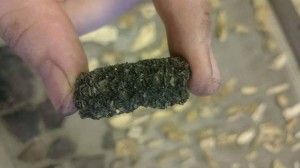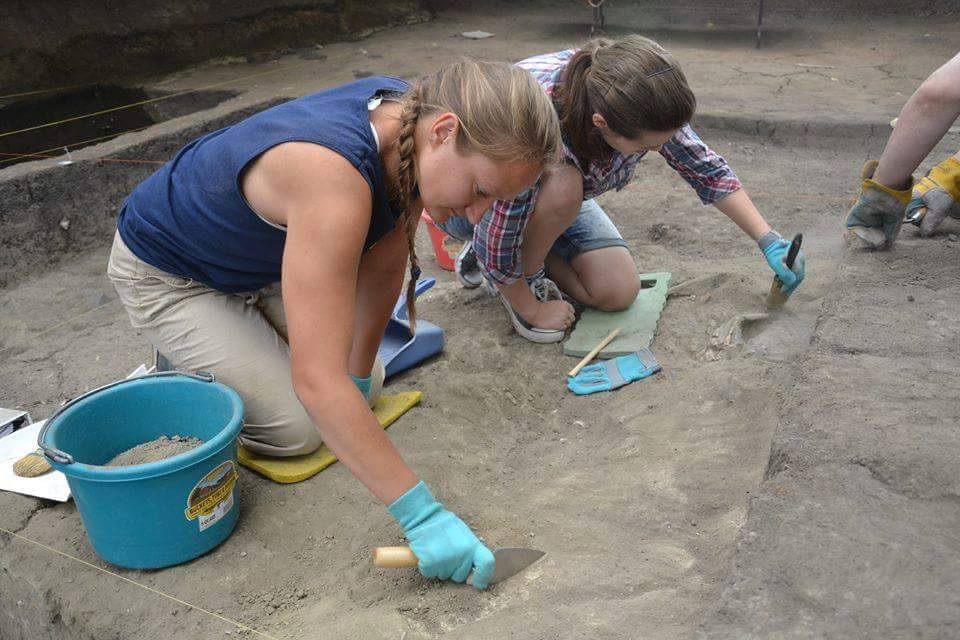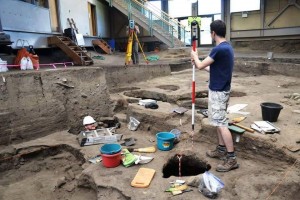For the past 12 years, archaeology students from the University of Exeter and its transatlantic partner, Augustana College, have been excavating the Mitchell Prehistoric Indian Village together. This year was the most productive year at the site with international newspapers and television networks covering the new developments at the excavation.
The Mitchell village stood a thousand years ago on a bluff overlooking Firesteel Creek, and it represents one of the earliest farming villages in the north of the US. Augustana’s Dr L. Adrien Hannus described the history and the landscape of the site in a most poetic way – “the prairie grasslands were spectacular […] it boasted grass with one to one and a half meters in height when the wind blew across the land it looked like a sea”. He further stressed the importance of the work in general, saying that “the sites are important along the Mississippi, because they represent the migrations of people that had moved north over several thousands of years, north out of Mexico, bringing with them the seeds of those plants”.
The Mitchell site was inhabited by ancestors of the Mandan (which today inhabit North Dakota), who lived in large, square earth lodges and had a rich lifestyle sustained by trade, fishing, hunting, and agriculture.
The Mitchell site may only be one village, but it gives us an important glimpse into the story of the early peoples of America; the migrations of peoples, cultures, and technologies from modern day Mexico to the north of the continent. Mitchell shows us that the peoples of the past were not so ‘primitive’ after all, as Hannus stresses, “there is direct evidence here at the Mitchell site of long distance trade, we find shell here at the site that comes from Florida, shell that comes from the pacific coast of California, we have some obsidian here […] probably this obsidian comes from the area of Yellowstone in north western Wyoming. The people were extraordinary well adapted to their environments and probably had a very decent life”.

Grain discovered at the site. Photo: Hayden Cooper
This year, however, the site made several key discoveries; from thousand year-old charred plant remains and complex fishing lures, all the way to grass linings of cache pits (underground food storage), and the first ever intact pot found on the site. Much of this was picked up initially by local press, but then it spread like wild fire across associated press with everywhere from the Times of India to the Daily Mail, and even Canadian television networks reporting on the wealth of finds. In particular, the agricultural findings have been particularly phenomenal this year; more organic material were found in a 2 week period than in the previous 11 years. Coupled with findings of fishing materials, and ho’s made out of bison scapula, the intricate picture of Mitchell is slowly being pieced together.
Exeter’s own Alan Outram spoke of the remarkable similarities of the finds with the historical research that had been conducted on the peoples here, “What’s really fascinating about finding that grass lining is that even though we’re talking a thousand years ago it matches precisely with the ethnographic material from a hundred years ago” displaying the direct relationship of the past to the modern day and the continuity of tradition in the South Dakotan peoples.

Students meticulously excavate. Photo: Hayden Cooper
The field school offers multiple benefits for the students attending. Firstly, it offers hands-on experiences at an indoor working archaeological site, which is a bit of a rarity in itself; but it also offers an insight into the Midwestern way of living, something quite off the path of regular tourists. Deep in what is still today considered the agricultural heart of America, Exeter students can make their own path of discovery up to Mitchell.
Outram gave his insights into this year at the site, reminding us that although the press picked up on the extraordinary finds they often miss the true meaning of archaeology. “All of that is pretty exciting as a season, but it isn’t ever the individual sort of finds that isn’t interesting to archaeologists, it’s building the whole picture that is most exciting, it’s not a treasure hunt, it’s putting together the information and taking pleasure about being able to find a bit more about the past in small pieces”. The site at Mitchell is more than just charred corn; it is the story of real people who lived and thrived on the South Dakotan plains.
This story was originally published by student newspaper Expose at http://exepose.com/2015/09/17/exeter-students-at-the-mitchell-prehistoric-indian-village/

